To become truly immortal a work must escape all human limits; logic and common sense will only interfere. But once these barriers are broken, it will enter the regions of childhood visions and dream. – Giorgio de Chirico
The art and poetry of “1 Cent Life” began as a dream by Chinese born artist Walasse Ting (October 13, 1929 – May 17, 2010) – to bring together a community of artists caught between the moment of abstract expressionism and pop-art in the early 1960s.
In 1962, Ting began discussing the publication with his friend, artist Sam Francis. Both men shared strong interests in calligraphy, I-Ching, Henri Matisse and the crossing of East-West culture. Ting wished to combine an array of contemporary artists who worked in many different styles into a single anthology, linking them together with his own art and poetry.
“1 Cent Life” was a landmark publication of 1964, and is now a rare book based on the impressive artwork it contains. It was a revolutionary tract for a collective aesthetic; an assembled vision of Pop and European abstraction, featuring flat hard-edged drawing and splatter painting, biomorphic art, splashing florescent colors and monochromes all meeting up in a single loud and dynamic package. “1 Cent Life” is among the most beautifully conceived and artistic book-works of the 1960s, unlike anything published before or after. It was a compact visual manifesto of the sixties – bright, psychedelic and pulsating, a collaboration of artists who came together under Walasse Ting’s poetic street magic.
With large empty spaces next to areas of maximum color saturation and layered density, “1 Cent Life” was an inspirational book of 1960s design and spirit – a polyglot enterprise –and certainly Ting’s best known work.
Ting’s poems are jarring mystical street-life incantations, sometimes epic and soaring, screamed out in all-capitalized letters or whispered in lower-case. Ting creats a language of dreams and vulgarity, choked off from reality, lacking standard grammar and punctuation, soaked with impulsive wit and exoticism. His pidgin English is the language of a new consciousness – a tongue that is bound with the earth and sky, inflamed and out of sync with technology and the world. His poetics borrow from classical Chinese poetry blended with urban dynamics and jazz riffs, the pathway of an open heart. Ting is a difficult poet but always true to himself; a poet of the street.
WHAT IS SMALL BUSINESS
NOBODY SMALL
YOU LAUNCH STEAMSHIP
I PUSH LOCOMOTIVE
YOU TALK TO MOUNTAINS
I LISTEN TO SEA
YOU EMBRACE RAINBOW
I KISS RAIN
YOU COVER SUN WITH YOUR FINGER
I MOVE MOON IN MY EYES
THOUSAND FLOWERS
BLOSSOM IN OUR BIG HEART
THOUSAND YEARS – Walasse Ting
“1 Cent Life” was dedicated to the maverick Detroit-based contemporary art collector Florence Barron, most famously known as the woman who in 1963, commissioned Andy Warhol to produce his first self-portrait. It’s speculated that Florence Barron put up the funds necessary to print the edition, as one of the main themes of her collection was her love of books and words and their relationship to contemporary art, advertising media and culture. Florence was also very close friends with Ting, an artist she supported and promoted to her friends throughout her life. Several times she brought Ting to Detroit supporting his exhibitions and projects.
This ‘un-livre d’artiste’ is a unique combination of quintessential American Pop Art and European Expressionism with 62 lithographs…..This undertaking is the simple instance in which artists of two essentially contradictory philosophies of art were brought together in one unexpectedly cohesive book. – Riva Castleman
“1 Cent Life” is a large unbound elephant-folio containing 62 original lithographs made by 28 European and American artists with 62 letterpress poems by Walasse Ting and set in multi-colored inks. The 172 page portfolio was written by Walasse Ting and edited by Sam Francis. The lithographs are by; Walaase Ting (6 lithos); Pierre Alechinsky (5 lithos); Karel Appel (5 lithos); Enrico Baj (2 lithos); Alan Davie (2 lithos), Sam Francis (“Pink Venus Kiki” + 5 other lithos); Robert Indiana (2 lithos); Asger Jorn (2 lithos); Roy Lichtenstein (Cover + 1 litho); Joan Mitchell; Claes Oldenburg (3 lithos: “Parade of Women” + “All Kinds of Love 1 & 2”); Mel Ramos (2 lithos), Robert Rauschenberg (2 lithos);Joan Mitchell, Allan Kaprow, Rinehound, Jim Dine, Jean-Paul Riopelle, James Rosenquist; Antonio Saura, Kimber Smith, K.R.H. Sonderberg, Bram Van Velde; Oyvind Fahlstrom, Andy Warhol, and Tom Wesselmann (2 lithos).
The text is in English, and the work is contained in silkscreened cloth boards and dust jacket, housed in a cloth covered slipcase.The lithography was realized and printed in Paris by Maurice Beaudet and the typography carried out in handset letterpress by George Girard. The book was published by E. W. Kornfeld, Bern, Switzerland in 1964, and edited by artist Sam Francis. In addition to the original printing of 1900 unsigned copies, there was a numbered portfolio edition of 100 signed copies in a pink cloth-covered solander box.
The idea was born from global experience, close contact with culture, pseudo-culture, primitive existential worries, urban erotic and eastern wisdom.. It was a Herculean task, for which only a Chinese would have been able to muster the perseverance. – E. W. Kornfeld

Silk screened front cover of the book “rose” by Roy Lichtenstein (right). Back cover “tireur de langue” by Pierre Alechinsky (left).
The chosen title; “1 Cent Life” is ambiguous and unclear. The title could refer to the “one cent life” of poverty that Ting lived in his early career – or as one’s sent life – Ting’s own journey that brought him from the small village of Wuxi to Shanghai, Paris and New York City, the center of the cosmopolitan art world. The title could also be a nod to a larger spiritual or artistic creator, who brought the unity of the collection together. Ting’s ideas and canvas were always in the moment, a reflection of a zen eternity is present in everything.There is no hierarchy or order to “1 Cent Life”, no single artist dominates the book and all pages are loose and removable. The book is steeped in a free-wheeling anarchy -a riotous color scheme seems to be the only rule it follows.
Ting wrote a brief autobiographical poem as an introduction to the silk-screen portfolio Fresh Air School (1972-1973), a collaboration with Joan MItchell, Sam Francis and Ting, published by the Carnegie Institute Museum:
WALASSE TING by WALASSE TING
Born in Shanghai, China, 1929
4 years old paint in sidewalk. 10 years
old draw on wall. 20 years old left
China to traveling after reading the
book of I-Ching. In 1953 arrived in
Paris. Six months later meet Pierre
Alechinsky. Six months later meet
Asger Jorn. Six months later meet
Karel Appel; drink coffee with them
in Paris-Café. Working all kinds of job
to making a very simple living. Living
in a six inches window room. Paint
there, eat there. In 1963 arrived in
New York City. Six months later meet
Sam Francis. Six months later meet
Tom Wesselmann. Six months later
meet Claes Oldenburg. Eat hot & sour
soup with them in Chinese restaurant.
Not working any kinds job. Sleeping
all day living in a sixty feet window
loft. Eat there, paint there. Self-
taught. Individual. Not belong to any
group.
Ting’s respect for the low and neglected, is equally evident throughout the text, where painting, women, sex and food are at the book’s core. There is little concern for monetary consideration in poems where prostitutes, bums, movie stars, the Pope and J.F.K. all share equal billing. When Ting first arrived in Paris from China he lived for many years in a one room apartment on the verge of poverty. While in Paris he met the artist Pierre Alechinsky (who he educated and taught calligraphy yo) later befriending many other members of the color focused expressionist CoBrA group who he’s since become tightly associated with. In the 1970s, Ting’s work developed into a combination of calligraphic styled brush painting and explosive neon color featuring nude women. Ting moved to New York City in 1960 where he moved in circles of both abstract expressionism and pop art.
“one life too short
one day too long” — Walasse Ting
In 2002 Ting suffered a severe brain hemorrhage and was diagnosed clinically brain dead. He lived in a nursing home just outside Amsterdam, the Netherlands. In 2009, his Amsterdam based dealer Nico Delaive gave a press conference and an exhibition titled “Walasse Ting 80th Birthday!” to bring attention to his sad condition. Walasse Ting died in 2010, soon after moving back to New York City. He created a total of 13 books, each one a delightful journey and celebration of life, color and poetry. “So many things to do and no time to die… your blood and my blood make truth,” he wrote in My Shit and My Love, a book of 10 poems and lithographs published in 1961 -the title was taken from a series of five unpublished love poems he wrote for his close friend Nela Arias. In many ways his book My Shit and My Love was an early model for 1 Cent Life. It was a shorter but similar tall portfolio with the same tangled mass of color and design, printed by the same superb French lithographers for 1 Cent Life, matched up with Ting’s raw street poetry.
According to Delieve, “he couldn’t paint colour without sex. Before sex he paints with black and white; after sex, it’s like his life has been lit up. And food, I have never seen anyone enjoy great food as much as he did. And now the nurse has to push food into his mouth, and the woman he had loved and lived with for 18 years is not allowed to be there with him. I can’t imagine he would like to live in this way… Walasse Ting is alive! But the way he lives is simply inhuman!” ( quoted source: Gallery Delaive)
“Please look this book on toilet, If you like
buy me cup of coffee next time you see me…”
–Walasse Ting, copyright page from “Red Mouth”

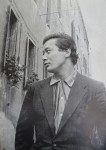

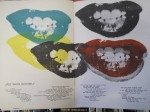

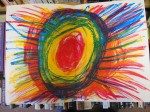
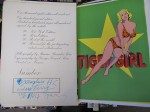
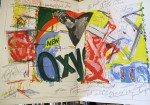
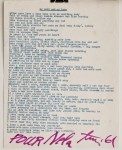





















One currently being auctioned at Swann ending 22 April. Current bid $1300.
https://live.swanngalleries.com/lots/view/4-GEWEQ5/ting-warhol-lichtenstein-et-alia-one-cent-life
current bid $3800 4/17/25